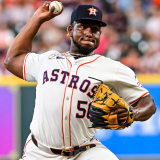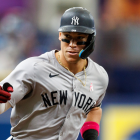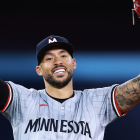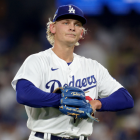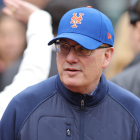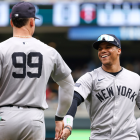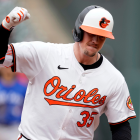
At long last, the longest lockout and the second longest work stoppage in baseball history is over. MLB and the MLBPA agreed to a new collective bargaining agreement on Thursday, ending the work stoppage at 99 days. Now the offseason can resume and soon spring training will begin, and the powers that be will try to act like nothing ever happened.
It was easy -- very easy -- to tune out baseball during the lockout because almost nothing happened. A few managers and coaches were hired, and a few minor league deals were struck, and that's it. Moves involving MLBPA members (i.e. 40-man roster players) were prohibited, and let's be real, those are the exciting moves. The other stuff doesn't grab your attention quite as much.
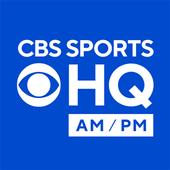
CBS Sports HQ Newsletter
Your Ultimate Guide to Every Day in Sports
We bring sports news that matters to your inbox, to help you stay informed and get a winning edge.
Thanks for signing up!
Keep an eye on your inbox.
Sorry!
There was an error processing your subscription.
Now that baseball is back up and running, let's look back at what happened before the lockout, during what we'll call Offseason 1.0. Here is the lapsed fan's guide to the 2021-22 MLB offseason, and a primer for Offseason 2.0.
Mets and Rangers spend big in free agency
The two most active teams prior to the lockout combined to lose 187 games in 2021. The Rangers gave out the two largest free agent contracts in terms of total dollars, inking Marcus Semien to a seven-year deal worth $175 million and Corey Seager to a 10-year deal worth $325 million. They also brought in Jon Gray and Kole Calhoun on shorter term contracts.
The Mets ramped up their spending with each signing. First came Eduardo Escobar at two years and $20 million. Then came Mark Canha at two years and $26.5 million. Then it was Starling Marte at four years and $78 million. And finally, the Mets topped it all off with Max Scherzer at three years and $130 million. It is far and away the richest contract ever in terms of average annual salary.
- Max Scherzer, Mets: $43.3 million
- Gerrit Cole, Yankees: $36 million
- Mike Trout, Angels: $35.5 million
- Stephen Strasburg, Nationals: $35 million
- Anthony Rendon, Angels: $35 million
Even with Semien and Seager (and Gray and Calhoun), the Rangers probably won't be good enough to contend in the AL West this year, though they're at least taking steps in that direction. The Mets clearly want to win the World Series in 2022. They could still use a back-end starter and bullpen help, but they greatly improved their roster before the sport shut down.
It should be noted the most active teams prior to the lockout all missed the postseason in 2021. Among others, the Tigers added Javier Báez (six years and $140 million) and Eduardo Rodriguez (five years and $77 million), the Mariners brought in Robbie Ray (five years and $115 million) and Adam Frazier (for two prospects), the Cubs signed Marcus Stroman (three years and $70 million), the Angels signed Noah Syndergaard (one year, $21 million) and re-signed Raisel Iglesias (four years, $58 million), and the Marlins imported Avisaíl García (four years, $53 million), Jacob Stallings (for three young players), and Joey Wendle (for one prospect).
That's the way it should be, right? The teams that missed the postseason (especially teams that barely missed the postseason, like Seattle) should be the most aggressive trying to improve their team in the offseason. In theory, they have the most to gain by adding new players and a few extra wins to their ledger. They're in position to get over the hump and have the motivation to act. We saw that leading into the lockout.
Yankees and Phillies sit out
"Sit out" isn't entirely correct because the Yankees and Phillies each made one reliever signing (Joely Rodríguez to New York and Corey Knebel to Philadelphia) as well as a minor two-for-two trade with each other, but that's really it. At minimum, the Yankees need a shortstop and the Phillies need a left fielder. In reality, both teams need much more help than that.
Other contenders were relatively quiet prior to the lockout as well. The Dodgers retained Chris Taylor with a four-year deal worth $60 million, both otherwise lost Scherzer and Seager, and Clayton Kershaw remains unsigned as well. The World Series champion Braves brought in Manny Piña (two years, $8 million), Darren O'Day (minor league deal), and Kirby Yates (two years, $8.25 million), and that's it. The Red Sox flipped Hunter Renfroe for Jackie Bradley Jr. and gave one-year deals to Rich Hill ($5 million), James Paxton ($10 million), and Michael Wacha ($7 million) in an effort to replace Rodriguez.
Of course, the offseason is not over, and the Yankees and Phillies (and Braves, Dodgers, Red Sox, et al) can still upgrade their rosters in a meaningful way before Opening Day. For now though, those teams didn't do much more than tinker with the margins of their roster, and they all have pretty significant questions to answer heading into 2022.
Athletics yet to move core players
All signs pointed to the A's slashing payroll and beginning a rebuild prior to the lockout. They let manager Bob Melvin go to the Padres for no compensation even though he had a year remaining on his contract, and they declined reliever Jake Diekman's affordable $4 million club option. With so many core players approaching free agency, an organization reset seems inevitable.
"We don't have an exact direction yet," GM David Forst said at the GM Meetings in November. "But you look at our history, and we have three or four-year runs and recognize where we are makes it necessary to step back. But we have not gotten to that point yet with ownership. Until that plan is really there, it's hard to sort of time everything out."
The reset never did come before the lockout. The Athletics picked up erstwhile top prospect Brent Honeywell Jr. in a minor trade with the Rays and that's it. Chris Bassitt, Matt Chapman, Ramón Laureano, Sean Manaea, Frankie Montas, and Matt Olson all remain. Could the A's keep those guys and try to make one last run with this group in 2022, especially with the postseason expanded to 12 teams? Sure. Do I think it will happen? Nah. Look for Oakland to be busy now that the lockout is over.
Trade market takes a backseat
Free agency was so hectic in the days leading up to the lockout that teams put trade talks on the back burner. The Athletics kept their core guys and other trade candidates like Josh Donaldson, Tyler Glasnow, Josh Hader, and Ketel Marte stayed put. There were 17 trades involving MLB players before the lockout. Here's the breakdown:
- Only two involved MLB players going both ways (Renfroe for Bradley plus two prospects, Stallings for Zach Thompson and two prospects).
- Nine involved a fringe 40-man roster player being traded for cash and/or a player to be named later.
- One was a pretty obvious salary dump (Tucker Barnhart to the Tigers).
- Not a single MLB.com top 100 prospect was traded.
The trade market will undoubtedly pick up now that the lockout is over because some teams won't like free agent prices and will look for other ways to add to their roster, and some teams want to unload veterans. It seemed like the free agent frenzy had teams focusing their attention on that market, causing the trade market to freeze. That should change now that work has resumed.
Big money extensions
November extensions happen but they are uncommon. Teams typically focus on outside additions during the winter months, then shift gears and look to retain their own players in February and March. Spring training is usually when we see most contract extensions signed, but this offseason several players opted not to wait around, and signed their deals early.
Here are the five long-term (i.e. four years or more) extensions signed prior to the lockout:
- Sandy Alcantara, Marlins: 5 years and $56 million with one club option
- José Berríos, Blue Jays: 7 years and $131 million
- Wander Franco, Rays: 11 years and $182 million with one club option
- Andrés Muñoz, Mariners: 4 years and $7.5 million with three club options
- Antonio Senzatela, Rockies: 5 years and $50.5 million with one club option
Obviously the Franco extension is the headliner. It is easily the largest contract ever given to a player with less than one full year of service time, eclipsing Ronald Acuña Jr.'s eight-year, $100 million deal with the Braves. Franco went into 2021 as the game's top prospect and performed at an All-Star level once called up, so Tampa took the plunge and locked up their cornerstone.
Berríos joined the Blue Jays at last year's trade deadline and was set to become a free agent next offseason. Toronto is clearly a team on the rise and they opened up the wallet to make sure Berríos is part of their World Series contention window. Alcantara is one of the game's unheralded great pitchers and the extension buys out two free agent years with a club option for a third. The Marlins made sure to lock up their ace as they begin to move toward contention.
There figure to be a rush of trades and free agent signings in the coming days, then once camp starts and teams can catch their breath a little bit, expect to see more extensions. Potential extension candidates include Nationals wunderkind Juan Soto (who turned down a $350 million offer), Brewers co-aces Corbin Burnes and Brandon Woodruff, Red Sox masher Rafael Devers, Blue Jays stars Vladimir Guerrero Jr. and Bo Bichette, and Padres hometown righty Joe Musgrove.
Carlos Correa and Freddie Freeman sweepstakes
Twenty-five of the top 50 free agents signed before the lockout, including nine of the top 13. Here are the 10 best free agents still on the market:
- SS Carlos Correa
- 3B Kris Bryant
- 1B Freddie Freeman
- SS Trevor Story
- OF Nick Castellanos
- OF Seiya Suzuki (still planning to come to MLB)
- LHP Clayton Kershaw
- RHP Kenley Jansen
- 1B Anthony Rizzo
- OF Michael Conforto
With all due respect to the other eight players, Correa and Freeman are the most compelling free agents available. Correa is a star at a premium position and he will play just about the entire 2022 season at age 27, making him the rare in-his-prime free agent. Seager is a year older than Correa and his 10-year, $325 million deal with the Rangers should be Correa's floor.
Is there a chance Correa takes a huge money one-year deal with an eye on cashing in during a normal offseason a year from now? I guess it's possible, but it's hard to see how his earning potential will ever be higher than it is right now. Getting that age 27 season has a ton -- a TON -- of appeal in a long-term contract. I think it's more likely Story takes a one-year deal, not Correa.
As for Freeman, it's a bit shocking he and the Braves did not work out a new deal before the lockout. He's said to be seeking six years and $180 million while Atlanta is offering something closer to Paul Goldschmidt's five-year, $130 million contract with the Cardinals. That seems like an easy enough bridge to gap, no? Freeman doesn't want to leave and the Braves don't want to lose him, so the middle ground at five years and $155 million or so could work. That said, the longer Freeman sits in free agency, the more likely it is he signs elsewhere, like with his hometown Dodgers.
Most of the top free agents signed prior to the lockout, though there are still several very good players and compelling figures sitting out there waiting to be signed now that MLB and the MLBPA have reached a deal. Correa and Freeman are chief among them, though Bryant, Story, and others are all worth big deals of their own. And, of course, there's the "would Kershaw leave the Dodgers?" question that we're no closer to answering now than we were three-plus months ago.
Managerial musical chairs
Four teams hired new managers this offseason. Not among them are the Yankees, who re-signed Aaron Boone to a new three-year contract despite a disappointing 2021 season. The Diamondbacks (Torey Lovullo) and Twins (Rocco Baldelli) opted against a new manager following their worst case scenario seasons as well. Here are MLB's four newest managers:
- Athletics: Replaced Bob Melvin with Mark Kotsay.
- Cardinals: Replaced Mike Shildt with Oliver Marmol.
- Mets: Replaced Luis Rojas with Buck Showalter.
- Padres: Replaced Jayce Tingler with Bob Melvin.
The Mets replacing Rojas and the Padres replacing Tingler was expected, and in both cases a young manager was replaced by a grizzled veteran. Melvin leaving the Athletics was a bit of a shock but not the craziest thing in the world either. Teams have been trying to pry Melvin, a three-time Manager of the Year, away from Oakland for years, and San Diego finally succeeded.
St. Louis firing Shildt was truly shocking. The Cardinals have gone to the postseason each of the last three years, yet president of baseball operations John Mozeliak cited a "philosophical difference" for the managerial change, which some took to mean Shildt wasn't onboard with an analytical approach. In Marmol, the Cardinals replaced Shildt with Shildt's bench coach. He is the youngest manager in baseball in age 35, and the hire suggests he is all-in on the team's use of analytics.
The next few weeks are going to be extremely busy as teams wrap up their offseason work, which includes signing their arbitration-eligible players and securing visas for players in other countries. It's not all about free agents and trades. There's much more to be done, and now that the lockout is over, teams can finally get back to work. Baseball is finally back.






















